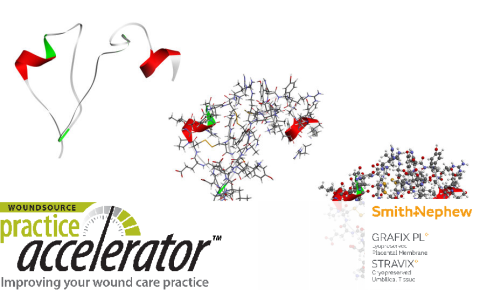How Growth Factors Support Wound Healing
February 28, 2021
Growth factors and cytokines are secreted by the cells and are essential to the complex wound healing and tissue regeneration process.1 This process involves the interplay of growth factors with chemokines, cytokines, and other signaling molecules.2 Although there have been numerous advances that have increased our understanding of wound healing, the exact tissue regeneration mechanisms following an injury have yet to be determined.1 Despite this knowledge gap, it is understood that growth factors are endogenous signaling molecules that regulate cellular processes during the healing phase.
They are naturally occurring polypeptides.3 Once growth factors are secreted, they act through autocrine, paracrine, or endocrine mechanisms by binding to membrane or cytoplasmic receptors.4 The action of binding triggers a series of events that activate the cellular responses required for wound healing. Even in low concentrations, growth factors can have an extraordinary impact on the wound microenvironment by increasing cell migration, proliferation, and differentiation.4
How much do you know about complex wounds? Take our 10-question quiz to find out! Click here.
Studies looking at complex, chronic, and non-healing wounds have demonstrated deregulation of several growth factors, thus leading to much interest in using growth factors and cytokines to improve the outcomes of non-healing wounds. Recombinant or exogenous growth factors are routinely used in a variety of surgical settings, including burn surgery, oral surgery, orthopedic surgery, and plastic surgery.4i The topical administration of growth factors after debridement may also be a promising approach to treating chronic wounds. These growth factors can be found in several approved medications available for external use in the form of gels, creams, ointments, and solutions.4
Specific Growth Factors Used in Wound Care
Growth factors available for topical administration include platelet-derived growth factor (PDGF), vascular endothelial growth factor (VEGF), epidermal growth factor (EGF), basic fibroblast growth factor (bFGF), and granulocyte-macrophage colony-stimulating growth factor (GM-CSF), among others.4iii
- PDGF: Used to treat diabetic foot ulcers (DFUs), this growth factor regulates cell growth and division and angiogenesis and acts as a chemoattractant for mesenchymal cells.4iii
- VEGF: Used to treat DFUs, this growth factor initiates angiogenesis, as well as proliferation and migration of the endothelial cells.4
- EGF (topical or intralesional injection): This growth factor is used to treat burns, non-healing ulcers, and DFUs. It stimulates the proliferation and migration of keratinocytes and increases the tensile strength of new skin.4
- bFGF: bFGF is used to treat pressure injuries, venous ulcers, and burns. It stimulates proliferation, migration, and angiogenesis in wounds.4
- GM-CSF (topical or subcutaneous injection): Used in the treatment of non-healing wounds and venous ulcers, this growth factor recruits Langerhans cells and stimulates proliferation and differentiation.4
Conclusion
The use of growth factors, such as those listed here, can be an important strategy in dealing with non-healing, chronic, and complex wounds. These growth factors mimic cell migration, proliferation, and differentiation, along with external modulation of the healing process.4 As our understanding of the pathophysiology of chronic wounds advances, growth factors offer promise for optimal wound management. However, at present, the clinical application of growth factors is limited by their short in vivo half-life resulting from low stability, restricted absorption around the wound area, elimination by exudation before reaching the wound area, and undesirable effects related to high local and/or systemic levels after topical administration.3
However, the use of biomaterials and growth factors to replicate the microenvironment and enhance the healing process shows great promise, particularly when multiple growth factors are applied during different stages of the healing process.3i

References
- Nurkesh A, Jaguparov A, Jimi S, Saparov A. Recent advances in the controlled release of growth factors and cytokines for improving cutaneous wound healing. Front Cell Dev Biol. 2020;8:638.
- Castrano O, Perez-Amodio S, Navarro-Requena C, Mateos-Timoneda MA, Engel E. Instructive microenvironments in skin wound healing: biomaterials as signal releasing platforms. Adv Drug Deliv Rev. 2018;129:95-117.
- Park JW, Hwang SR, Yoon I. Advanced growth factor delivery systems in wound management and skin regeneration. Molecules. 2017;22(8):1259. https://doi:10.3390/molecules22081259. Accessed February 15, 2021.
- Yamakawa S, Hayashida K. Advances in surgical applications of growth factors for wound healing. Burns Trauma. 2019;7(10):1-10.
The views and opinions expressed in this blog are solely those of the author, and do not represent the views of WoundSource, HMP Global, its affiliates, or subsidiary companies.












Follow WoundSource
Tweets by WoundSource